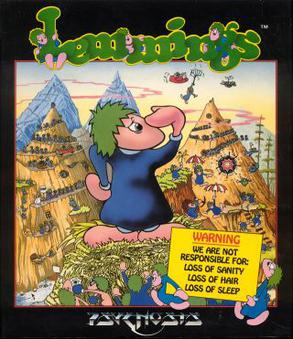
Lemmings is a puzzle–strategy video game originally developed by DMA Design and published by Psygnosis for the Amiga in 1991 and later ported for numerous other platforms. The game was programmed by Russell Kay, Mike Dailly and David Jones, and was inspired by a simple animation that Dailly created while experimenting with Deluxe Paint.

Sinbad the Sailor is a fictional mariner and the hero of a story-cycle. He is described as hailing from Baghdad during the early Abbasid Caliphate. In the course of seven voyages throughout the seas east of Africa and south of Asia, he has fantastic adventures in magical realms, encountering monsters and witnessing supernatural phenomena.

Wonder Boy in Monster Land, known by its original arcade release as Wonder Boy: Monster Land, is a platform video game developed by Westone Bit Entertainment and released by Sega in Japanese arcades in 1987 and for the Master System in 1988, with a number of other home computer and console ports following. The game is the sequel to the 1986 game Wonder Boy and takes place eleven years after the events in the previous game. After enjoying over a decade of peace on Wonder Land following the defeat of the evil King by Tom-Tom, later bestowed the title "Wonder Boy", a fire-breathing dragon called the MEKA dragon appeared; he and his minions conquered Wonder Land, turning it into "Monster Land". The people, helpless due to their lack of fighting skill, call for Wonder Boy, now a teenager, to destroy the monsters and defeat the MEKA dragon. Players control Wonder Boy through twelve linear levels as he makes his way through Monster Land to find and defeat the MEKA dragon. Players earn gold by defeating enemies and buy weapons, armor, footwear, magic, and other items to help along the way.
Ninja Gaiden is a media franchise based on action video games by Tecmo featuring the ninja Ryu Hayabusa as its protagonist. The series was originally known as Ninja Ryukenden in Japan. The word "gaiden" in the North American Ninja Gaiden title means "side story" in Japanese. The original arcade version, first two Nintendo Entertainment System games and Game Boy game were released as Shadow Warriors in PAL regions. As of 2008, the series has shipped over 7.7 million copies.
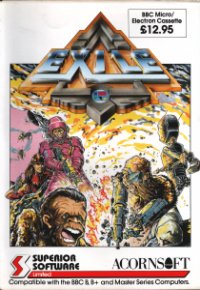
Exile is a single-player action-adventure video game originally published for the BBC Micro and Acorn Electron in 1988 by Superior Software and later ported to the Commodore 64, Amiga, CD32 and Atari ST, all published by Audiogenic. The game was designed and programmed by Peter Irvin and Jeremy Smith. It is often cited as one of the earliest examples of a Metroidvania game and featured "realistic gravity, inertia and object mass years before players understood the concept of a physics engine... an astounding level of AI, stealth-based gameplay, a logical ecosystem governing the world's creatures and a teleportation mechanic that feels startlingly like a predecessor to Portal".

Dark Castle is a 1986 platform game for Macintosh that was originally published by Silicon Beach Software. The original game was designed and animated by Mark Pierce and programmed by Jonathan Gay with Real Sound by Eric Zocher. In Dark Castle, a young hero named Duncan tries to make his way to the evil Black Knight, dodging objects as well as solving occasional puzzles.

Twinworld is a video game, published by Ubi Soft for the Amiga and Atari ST in 1989. Ports for the Commodore 64, Amstrad CPC, and Acorn Archimedes were released in 1990.

Aaargh! is a single-player action video game in which the player controls a giant monster with the goal of obtaining eggs by destroying buildings in different cities across a lost island. It was designed for Mastertronic's Arcadia Systems, an arcade machine based on the custom hardware of the Amiga, and was released in 1987. It was ported to a range of other platforms and released on these across 1988 and 1989. Electronic Arts distributed the Amiga version of the game.

Shadow Dancer is a side-scrolling hack-and-slash action game produced by Sega and originally released as an arcade game in 1989. It is the second and the final arcade game in the Shinobi series, following the original Shinobi itself. The player controls a ninja aided by an attack dog, who is fighting to save the city from a terrorist organization.
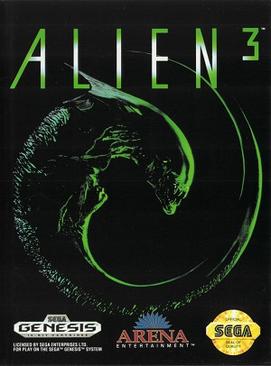
Alien 3 is a run and gun game based on the 1992 film of the same name. It was released for the Genesis and Amiga in 1992, then for the Commodore 64, Game Boy, Game Gear, Nintendo Entertainment System, Super Nintendo Entertainment System, and Master System.
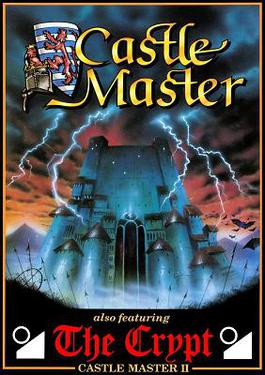
Castle Master is a 1990 video game by developer Teque Software Development and published by Incentive Software. It was released for the ZX Spectrum, Commodore 64, Amstrad CPC, Amiga, Atari ST and IBM PC. A compilation was released also in 1990 that contained the original and the sequel, Castle Master II: The Crypt.

Sinbad and the Throne of the Falcon is a 1987 action-adventure game developed and published by Cinemaware. Set in an Arabian Nights-esque world, the player assumes the role of Sinbad the Sailor, and is commissioned by The Princess to rid the land of the Dark Prince. The game was designed and programmed by Bill Williams for the Amiga, who also wrote Mind Walker. Sinbad and the Throne of the Falcon was ported to the Atari ST, Apple IIGS, MS-DOS, and Commodore 64.

Sonic and the Secret Rings is a 2007 platform game developed by Sonic Team and published by Sega for the Wii. A spin-off from the Sonic the Hedgehog series, it is the first title in the franchise for the system, and follows Sonic the Hedgehog's quest to stop an evil genie named the Erazor Djinn. In addition to the basic platforming gameplay of previous Sonic titles, Secret Rings uses a system of experience points and levels, as well as special moves that are unlocked by means of progression.
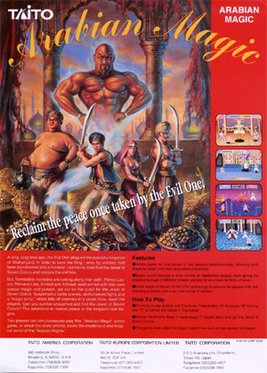
Arabian Magic is a side-scrolling hack-and-slash arcade video game developed by Taito and released in 1992. It was included in Taito Legends 2 for Microsoft Windows, PlayStation 2, and Xbox.
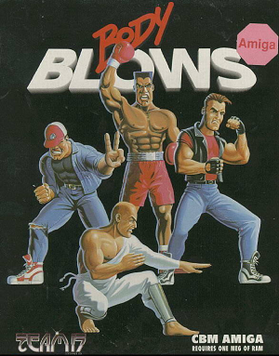
Body Blows is a 1993 fighting game, developed and published by Team17 for Amiga. A version for MS-DOS followed the same year. The game has been compared to Street Fighter II. It was followed by Body Blows Galactic and Ultimate Body Blows.

Loaded is a science fiction-themed top-down multidirectional shooter developed by Gremlin Interactive. Loaded was released on December 15, 1995 on the PlayStation, and was ported to the Sega Saturn the following year. The game had origins in DC Comics as well as the more adult-orientated Vertigo Comics, and there was a small graphic novel based on the game. The six playable characters of the game are a combination of villains, anti-heroes, psychopaths, perverts, mutants, and flamboyant murderers. They are, however, the best hope to stop the intergalactic supervillain nicknamed F.U.B. and save the universe. The characters were created and designed with contributions from Garth Ennis of Vertigo Comics and Greg Staples of 2000AD.
Baldur's Gate III: The Black Hound was a cancelled role-playing video game developed by Black Isle Studios for the Microsoft Windows platform. Announced in 2002 under the codenames FR6 and Project Jefferson, it was planned to be the third main entry in the Baldur's Gate series, utilizing the Dungeons & Dragons 3rd Edition ruleset. The game was set to use a 3D graphics engine developed for the game, rather than the Infinity Engine used for the developer's previous games.

Jurassic Park is a 1993 action video game developed and published by Ocean Software, for DOS and Amiga computers. The game is based on director Steven Spielberg's 1993 film, Jurassic Park, and also includes elements from author Michael Crichton's 1990 novel of the same name, which the film is based upon.
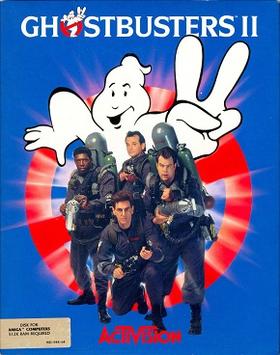
Ghostbusters II is a 1989 action game based on the film of the same name. It was published by Activision for various computer platforms. British studio Foursfield developed a version for Commodore 64, Amiga, Atari ST, Amstrad CPC and ZX Spectrum, which also got ported to the MSX by New Frontier. It features three levels based on scenes from the film. Dynamix developed a separate version for the DOS, also based on the film. The non-DOS versions were praised for the graphics and audio, but criticized for long loading times, disk swapping, and the final level. The DOS, Commodore 64 and Amiga versions were the only versions released in North America.
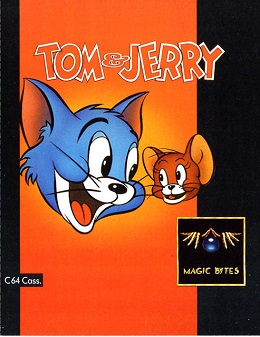
Tom & Jerry is a 1989 platform game developed and published by German company Magic Bytes. It is the first video game based on the cartoon of the same name, and was released in the United States and Europe, for Amiga, Atari ST, and Commodore 64 computers.


















